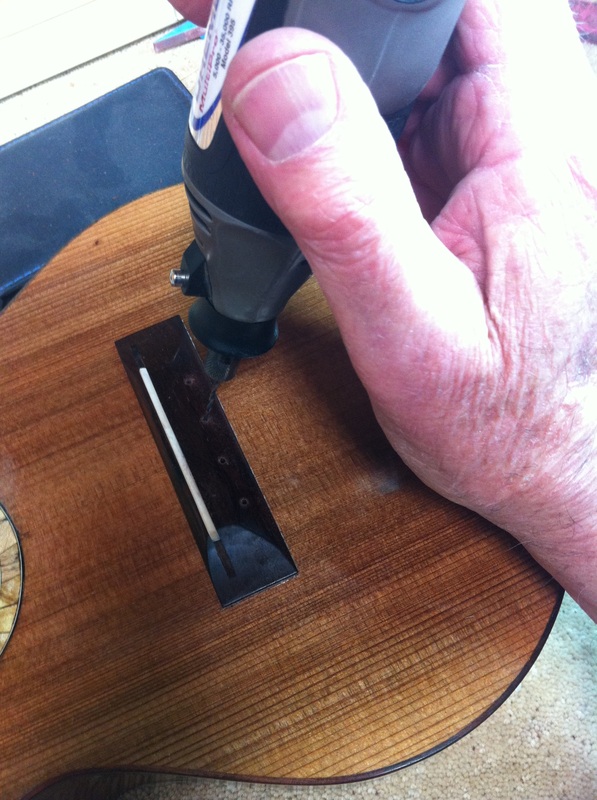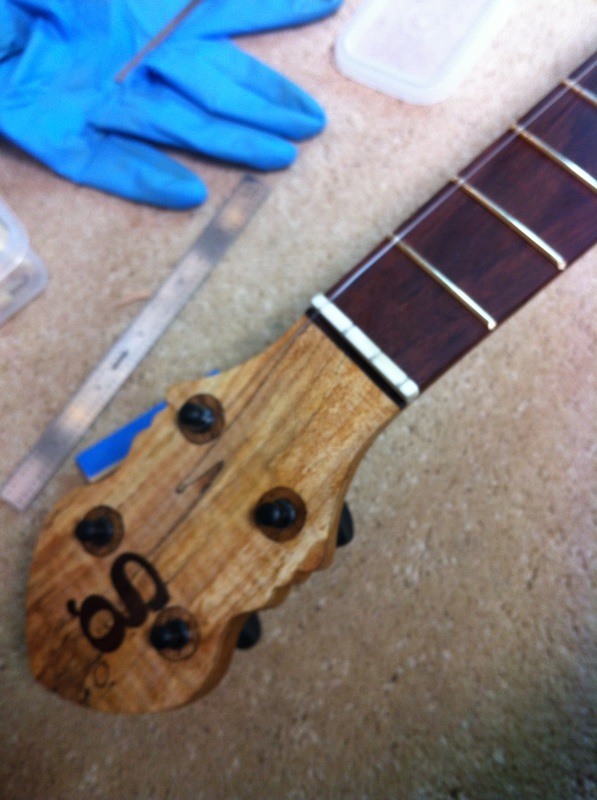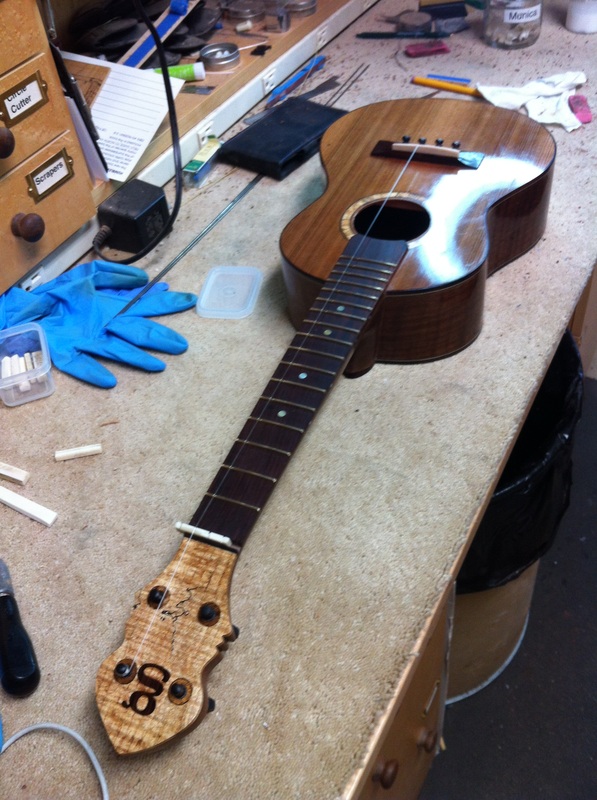THIS MORNING I began with all the bridges glued on. It was time to install the tuners, drill the holes for the bridge pins, make the bison bone nuts and saddles and see if I could get the strings on. Here is how it went
| 1. first I installed the Pegheds. The tapered auger carved out the holes to just the right width and with a drop of glue, the Pegheds are threaded into the wood. then it is possible to attach a string, run it down the length of the fretboard and determine where to drill the hole in the bridge. Here I am using a very small drill in a Dremel tool to start the hole after first pricking the exact spot with an awl 3 . The Pegheds go in easily if you have the proper tapered auger and you cut it into the hole the proper distance. I thought they looked fine with my new koa surrounds. 5. Now the bridge pin tip just enters the hole. You must carefully auger out the tapered hole so that it is entirely seated. Go very slowly, cutting, trying, cutting again. You want it to just seat, firmly not loosely. 7. Ah! the first bridge pin is seated exactly right 9. With all the pins fitted snuggly into the holes now you must saw a small groove for the string to run beside the pin. The saw cut is made on the side of the hole, just large enough to accept the string. Exacto #75 is a perfect little thin saw to do this with. 11. with one string secured now you can make the bone nut and saddle and get the action in proximate height | 2. The string must be run from the tuner at the appropriate distance from the fretboard edge and then a mark made on the bridge where it crosses. Here is the Cedar/Koa uke getting its pin location determined. 4. This can be tricky. The rosewood bridge is hard and not easy to drill. I start with a tiny hole marked with a sharp awl, then I follow with a tiny drill bit and the Dremel, finally the hole large enough to accept the tapered pin auger is drilled with an old fashioned hand drill. You must not use a fast drill lest you tear up the rosewood. This bit goes through the rosewood bridge, and the Spruce top, and the walnut backing plate underneath. All holes were successful. 6. The auger has a 3 degree taper, same as the bridge pin, but there will be a tiny difference between the width of individual pins so you want to seat each pin individually. Takes a long time. 8. It is time to drill the next hole, Be Careful, don't hurry! D0n't slip! 10. An overhand knot is tied into the first string and it is inserted down the hole, laid into that saw cut and the bridge pin is pushed down to hold it in. Then the string is brought up to the tuner, and at last- the uke makes its first sound. 12. And now with all strings on- that great moment when you can bring them all upstairs in front of the fireplace and tune, pick, and tune again as the strings stretch in. by this time it was 5;15 and I poured myself a stiff drink. |
And here they are, left to right, The Cedar/Koa, the Englemann Spruce/Koa, and the Redwood/Claro Walnut.
The big news is they all sound great. The Cedar is predictably rich and warm, The Spruce is predictably a little cooler and needs some playing to richen up, but it will. The real question mark was the Redwood. I have never used Redwood before. I am really pleased. Walnut and Redwood have made a wonderful strong rich sound. It is going to be a fine instrument. I have a few little finishing touches to do, a strap button for Trey's Cedar/koa, a few sharp corners on nuts and saddles, a couple of little touch-ups to a few spots,and final adjustments to the actions, but these tenors are finally singing, and they are all going to be good ones. Whew!
The big news is they all sound great. The Cedar is predictably rich and warm, The Spruce is predictably a little cooler and needs some playing to richen up, but it will. The real question mark was the Redwood. I have never used Redwood before. I am really pleased. Walnut and Redwood have made a wonderful strong rich sound. It is going to be a fine instrument. I have a few little finishing touches to do, a strap button for Trey's Cedar/koa, a few sharp corners on nuts and saddles, a couple of little touch-ups to a few spots,and final adjustments to the actions, but these tenors are finally singing, and they are all going to be good ones. Whew!













